With Mary, into the love of things invisible
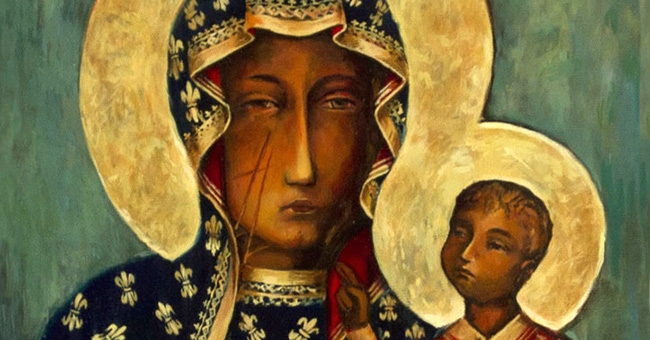
I gave the following homily at the Church of Our Lady of Czestochowa in Józefów on Saturday morning 13th August 2016. The Polish text, translated by Natalia Lajszczak was read by the Reverend Father Bartosz Porzeziński. For the English text of the homily, scroll down.
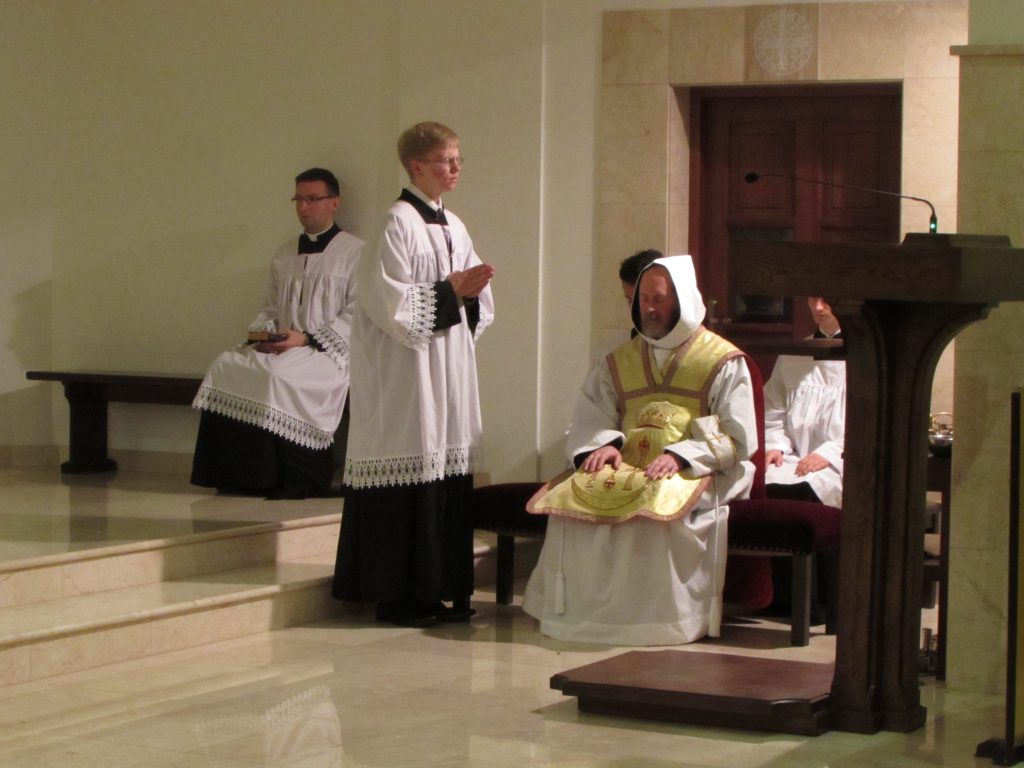 Józefów, 13 sierpnia 2016
Józefów, 13 sierpnia 2016
Msza na święta Najświętszej Maryi Panny rozpoczyna się słowami bezpośrednio zwróconymi do Matki Bożej. To samo w sobie jest bardzo niezwykłe. Zdecydowana większość antyfon na wejście w rycie rzymskim to słowa zaczerpnięte z psalmów, to wołanie do Boga: wołanie z niepokojem, wołanie z niezachwianą wiarą, wołanie w smutku, w radości, wołanie z uwielbieniem czy z dziękczynieniem. Dziś natomiast Kościół czerpie z twórczości Seduliusza, poety chrześcijańskiego z V wieku.
Dusza Kościoła wznosi się, by pozdrowić Najświętsza Matkę, która wydała na świat Króla. Druga część antyfony pochodzi z psalmu 44, który jest królewską pieśnią weselną. Matka Boża odpowiada w niej na pozdrowienie Kościoła. Jakimi słowami? „Z mego serca płynie piękne słowo; pieśń moją śpiewam dla Króla” (Ps 44,2). Cóż jest tym pięknym słowem wypowiedzianym przez Maryję? Czy to nie to samo słowo, na które czekało całe stworzenie? Czy to nie odpowiedź na zwiastowanie? „Oto ja służebnica Pańska, niechaj mi się stanie według słowa twego” (Łk 1, 38). A jaką pieśń Maryja śpiewa dla Króla? Czy to nie ta sama pieśń, którą ma na ustach w domu świętej Elżbiety? „Uwielbia dusza moja Pana.
I rozradował się duch mój w Bogu, Zbawicielu moim. Iż wejrzał na uniżenie służebnicy swojej. Bo oto błogosławioną zwać mię będą wszystkie
narody” (Łk 1, 46-48).
Dzisiejsza antyfona wyraźnie ma formę dialogu. To rozmowa między Kościołem
na ziemi, a Królową nieba. Po fragmencie z psalmu niebo i ziemia łączą się
we wspólnym wychwalaniu Ojca, Syna i Ducha Świętego. Poprzez tę antyfonę spoglądamy na tajemnicę każdej Mszy Świętej. Jest ona wypełnieniem tego, co zobaczył Jakub: „We śnie ujrzał drabinę opartą na ziemi, sięgającą swym wierzchołkiem nieba, oraz aniołów Bożych, którzy wchodzili w górę i schodzili na dół.”
W czytaniu zaczerpniętym z Mądrości Syracha słyszymy słowa samej Matki Bożej. Maryja przemawia do Kościoła zebranego na Świętej Ofierze. Ta, która jest „pełna łaski” (Łk 1,28) mówi nam o miejscu, które od zawsze miała w sercu Boga, o swoim udziale we Wcieleniu, o swojej roli w życiu Kościoła na ziemi i w niebie. „A przebywanie moje – mówi Maryja – w zgromadzeniu świętych” (Syr 24, 16).
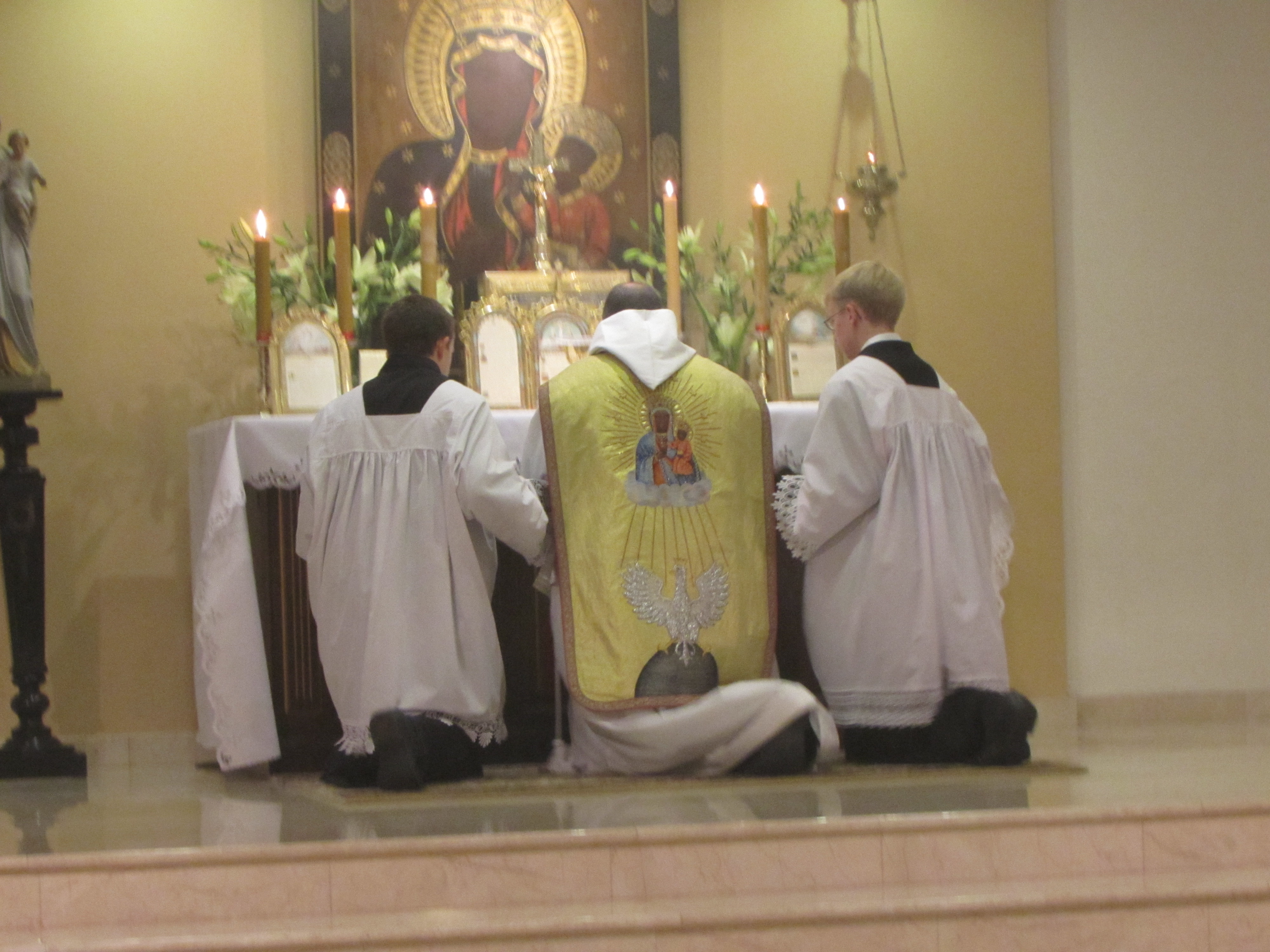
Śpiewając graduał i alleluja, Kościół odpowiada na słowa Maryi. Tu także, podobnie jak w antyfonie, Kościół zwraca się bezpośrednio do Matki Boga, kontemplując ją jakby w uniesieniu. Użyłem słowa „uniesienie” celowo, bowiem kontemplując Niepokalaną zawsze wznosimy się ponad samych siebie ku Bożemu światłu. Spoglądając bowiem na Maryję lub słuchając tego, co mówi, jesteśmy porywani do „umiłowania rzeczy niewidzialnych”, in invisibilium amorem rapiamur, jak śpiewamy w prefacji o Bożym Narodzeniu.
Dzisiejsza Ewangelia jest bardzo krótka. Główną rolę odgrywa w niej anonimowa kobieta znajdująca się w tłumie zebranym wokół Jezusa, by słuchać Jego słów.
To niezwykłe. Tłum ten jest obrazem Kościoła wsłuchanego w Ewangelię świętą. Kobieta jest tak poruszona słowami Jezusa, że nie potrafi milczeć. W Ewangelii czytamy, że odezwała się donośnym głosem, extollens vocem. Chce chwalić Jezusa, ale najlepszym sposobem na wychwalanie Syna wydaje jej się wysławianie Jego Matki. Jezus zwraca się do niej bezpośrednio: „Raczej ci są błogosławieni, którzy słuchają słowa Bożego i strzegą go” (Łk 11, 28). Słowa te mają znaczyć: „Ty także możesz być uczestnikiem świętości mojej dziewiczej Matki, jeśli tak jak ona będziesz słuchać moich słów i zachowasz je w sercu.”
W antyfonie na ofiarowanie Kościół w duchu radości powtarza słowa archanioła Gabriela i łączy je ze słowami świętej Elżbiety. Znaczące jest to, że mamy tu do czynienia ze słowami pochodzącymi z nieba, przyniesionymi na ziemię przez anioła oraz ze słowami wypowiedzianymi na ziemi, w górzystej Judei, w okrzyku podziwu wydanym przez Elżbietę, żonę Zachariasza. Gdy zatem pozdrawiamy pełną łaski Maryję słowami tej modlitwy, szczególnie powtarzając ją pokornie w różańcu, niebo przybliża się do ziemi, a ziemia do nieba.
Antyfona na komunię, którą w dawniejszych czasach powtarzano kilkakrotnie podczas podchodzenia wiernych do Komunii, potwierdza, że Najświętsza Eucharystia jest prawdziwie Ciałem Chrystusa utworzonym w łonie Maryi przez Ducha Świętego, noszonym przez Nią pod sercem przez dziewięć miesięcy, narodzonym w Betlejem i wykarmionym przez Najświętszą Matkę. Przyjmując Komunię Świętą, łączymy się w jedno Ciało, którego głową jest Chrystus. Podobnie każda Komunia Święta zacieśnia naszą więź z Maryją, jako matką całego Chrystusa, matką głowy Kościoła i matką ciała Kościoła. Ta, która urodziła tu na ziemi Syna Przedwiecznego Ojca, opiekuje się dalej jak matka wszystkimi członkami Ciała Chrystusa, czyli Kościoła. Wszyscy, którzy przyjmują Ciało Jej Syna są bliscy Jej matczynemu sercu, bowiem w każdym z nich rozpoznaje Ona Jego samego, kocha Go i stale ofiarowuje Ojcu.
To tylko kilka drobnych rozważań na temat dzisiejszej liturgii. Oby w jakiś sposób pozwoliły wam one otworzyć się na skarby doktryny i pobożności, i na życie zawarte w liturgii Kościoła. Liturgia bowiem nigdy się nie starzeje, nigdy nie jest nudna i nigdy nie traci smaku. Liturgia Kościoła, wszystko to, co znajduje się w Mszale, jest niewyczerpanym źródłem. Zawsze świeża, zawsze nowa, zawsze pełna czystej słodyczy Boga. Gustate et videte quoniam suavis est Dominus. „Skosztujcie i zobaczcie, jak dobry jest Pan” (Ps 33,9).
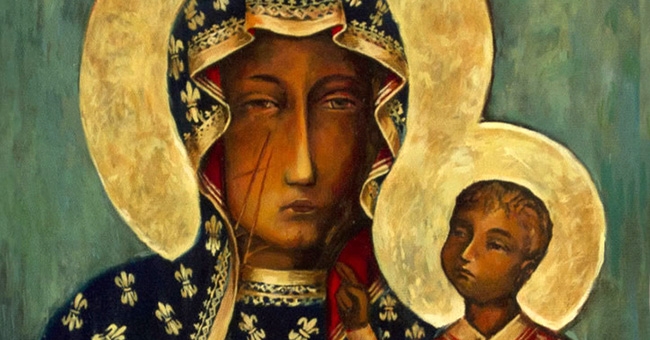
The Mass of the Blessed Virgin Mary on Saturday opens with an Introit addressed directly to the Mother of God. This, in itself, is most unusual. The vast number of introits of the Roman Rite, taken from the Psalms, are a cry going up to God: a cry of distress, of confidence, of hope, of sorrow, of jubilation, of praise, or of thanksgiving. Today, however, the Church draws upon the artistry of Sedulius, a Christian poet of the fifth century. The soul of the Church rises to greet the Holy Mother who brought forth the King. The verse is taken from Psalm 44, a royal wedding song. In it the Mother of God responds to the greeting of the Church. And what does she say? «My heart hath uttered a good word: I speak my works to the King» (Psalm 44:1). What is the good word that Mary has uttered? Is it not the word for which the whole creation waited? Is it not her response to the message of the Angel? «Behold the handmaid of the Lord; be it done to me according to thy word» (Luke 1:38). And what are the works that Mary speaks to the King? Are they not the verses of praise that came to flower on her lips in the Magnificat? « My soul doth magnify the Lord. And my spirit hath rejoiced in God my Saviour. Because he hath regarded the humility of his handmaid; for behold from henceforth all generations shall call me blessed» (Luke 1: 46–48).
It is clear that today’s Introit is a dialogue: a conversation between the Church on earth and the Queen of Heaven. After the psalm verse, earth and heaven join together in praise of the Father, the Son, and the Holy Ghost. In this one introit, we are given a window into the mystery of every Holy Mass. The liturgy is the fulfilment, daily, in our churches of what Jacob saw at Bethel in a dream: «And he saw in his sleep a ladder standing upon the earth, and the top thereof touching heaven: the angels also of God ascending and descending by it».
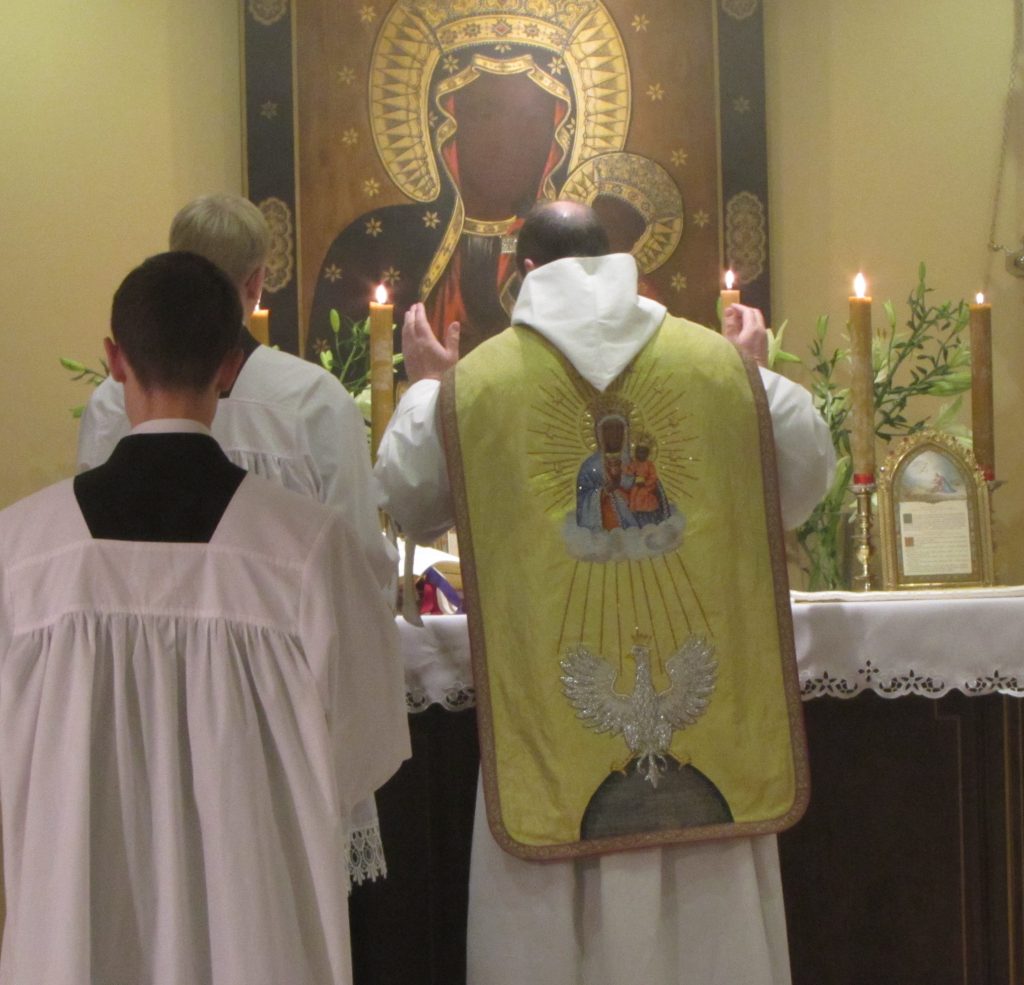 In the lesson of the Mass, taken from the book of Ecclesiasticus, it is the Mother of God who speaks. She opens her mouth in the assembly, that is in the Church gathered for the Holy Sacrifice. She who is «full of grace» (Luke 1:28) speaks to us of her place from all eternity in the heart of God, of her place in the economy of the Incarnation, of her place in the life of the Church on earth and in heaven. «And my abode», says Mary, «is in the full assembly of the saints» (Ecclesiasticus 24:16).
In the lesson of the Mass, taken from the book of Ecclesiasticus, it is the Mother of God who speaks. She opens her mouth in the assembly, that is in the Church gathered for the Holy Sacrifice. She who is «full of grace» (Luke 1:28) speaks to us of her place from all eternity in the heart of God, of her place in the economy of the Incarnation, of her place in the life of the Church on earth and in heaven. «And my abode», says Mary, «is in the full assembly of the saints» (Ecclesiasticus 24:16).
In the chant of the Gradual and the Alleluia, the Church responds to Mary’s discourse. Here again, as in the Introit, the Church addresses the Mother of God directly in a kind of ecstatic contemplation. I say «ecstatic» designedly, because the contemplation of the Immaculate always draws us out of ourselves and upwards into the light of God. One cannot gaze upon Mary, nor can one listen to her utterances, without being caught up, as we sing in the Preface of the Mass of Christmas, «to the love of things unseen», in invisibilium amorem rapiamur.
The Gospel given us in this Mass is very brief. It is unique in that, in it, the central place is occupied by an anonymous woman in the multitude of those who are gathered about Jesus to listen to Him. The multitude listening to Jesus is already an image of the Church, here present, listening to the Holy Gospel. A woman in the multitude is so touched by the words of Jesus that she cannot contain herself. The Gospel says that she lifted up her voice, extollens vocem. She wants to praise Jesus, but can think of no better way of praising the Son than by glorifying the Mother. Jesus then addresses the woman directly: «Yea rather, blessed are they who hear the word of God, and keep it» (Luke 11:28). He is, in effect, saying to the woman: «You also can participate in my Virgin Mother’s blessedness, if you, like her, hear my word and hold it in your heart».
In the Offertory Antiphon, the Church, in a spirit of jubilation, repeats the words of the Angel Gabriel and joins them to the words of Saint Elizabeth. This is significant: there is phrase originating in heaven, and brought to earth by an Angel, and a phrase originating on earth, in the hill country of Judea, and uttered in a cry of admiration by Elisabeth, the wife of Zachary. The «Ave Maria» antiphon of the Offertory suggests that, whenever we address Mary full of grace, in these words, especially in the humble repetition of the rosary, heaven is brought closer to earth, and earth brought closer to heaven.
The Communion Antiphon, which, in ancient times, would have been repeated throughout the procession of communicants, confesses that the Most Holy Eucharist is the very Body of Christ, formed by the Holy Ghost, carried for nine months in Mary’s virginal womb, born of her at Bethlehem, and nourished at her breast. The reception of Holy Communion unites us as one Body to Christ our Head, and as members of that same Body joined to each other. At the same time, every Holy Communion intensifies and deepens our relationship with Mary, for she is Mother of the whole Christ, Head and members. She who bore the Son of the Eternal Father, giving Him birth once in time, continues to mother His members. She holds close to her maternal Heart all who receive the Body of her Son, for in each one of His members she recognises Him, loves Him, and offers Him again and again to the Father.
These are but a few little thoughts on this Mass of Our Lady on Saturday. May they serve, in some way, to awaken each of you to the treasures of doctrine, of piety, and life contained in the liturgy of the Church. The liturgy of the Church never grows old, it is never dull, and never without savour. The liturgy of the Church — all that you find in the Missal — is an inexhaustible source. It is always fresh, always new, always full of the very sweetness of God. Gustate et videte quoniam suavis est Dominus. «O taste, and see that the Lord is sweet» (Psalm 33:9).
